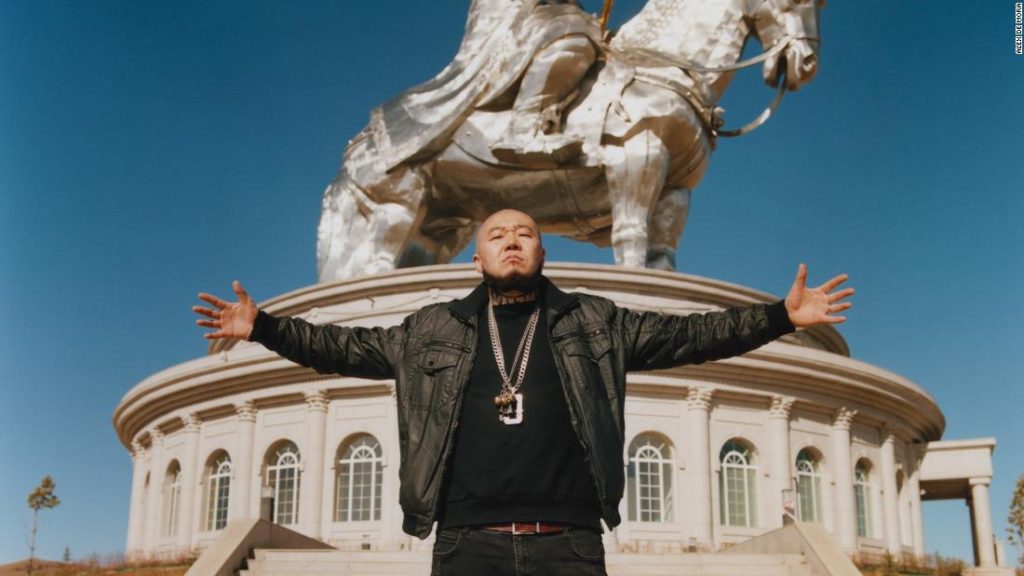It was 1996 when the young poet Tugsjargal Munkherdene heard American hip-hop for the first time.
Four years earlier, Mongolia’s Soviet-aligned government had fallen, opening the country to a fresh wave of cultural imports. The easing of state censorship heralded a new era of free expression. It also meant that G-funk, boom bap and gangster rap soon arrived on the airwaves — including the track that made a lasting impression on the then-teenage Munkherdene: Dr. Dre and Snoop Dogg’s “187 On an Undercover Cop.”
“I realized I could put my poems on a beat like them, and I started writing rap music,” he recalled in a video interview from his studio in Ulaanbaatar, Mongolia’s capital.
1/10
Rapper Big Gee riding a Bactrian camel in Mongolia’s capital. Scroll through the gallery to see more images from photographer and filmmaker Alex de Mora’s project, “Straight Outta Ulaanbaatar.” Credit: Alex de Mora
“We didn’t have recording studio — there were very few and (they were) very expensive. The start of my rap career was very hard,” he said. “We didn’t have a way to make good money, to make high-quality audio and video, or to work with big companies. Television and radio stations blocked our music and videos. They thought hip-hop was a bad thing.”
“When most people think about Mongolia, they think about big open expanses, and maybe they’ve heard of a two-humped camel or have seen people riding around on horses … but they’ve never thought about contemporary culture in an urban environment,” De Mora said on a video call from London. “That’s what I wanted to show — that across the world there are different things going on where cultures are crossing over.”

Mongolian rapper Maberrant, pictured by photographer Alex de Mora in the passenger seat of a car. Credit: Alex de Mora
Tackling social issues
Describing himself as “obsessed with music and subcultures,” De Mora has previously photographed high-profile US rappers like Pusha T, MF Doom and members of the Wu-Tang Clan. He often eschews the cliched tropes of hip-hop photography, an approach maintained during his self-funded trip to Mongolia. While some of the portraits show local rappers flaunting their jewelry or posing in — or on top of — their cars, many are warmer and more playful than the genre usually dictates.
“I try and avoid the obvious bravado-type portraits,” he said. “It’s quite funny when you get your camera out and a guy starts posing, which is good to have some of. But with this project I wanted to find more intimate and personal moments.”
Big Gee, whose image features on the cover of De Mora’s book, also serves as the documentary’s central figure and narrator. The issues he addresses tell a wider story about the challenges of life in Ulaanbaatar.

One of Ulaanbaatar’s sprawling ger districts. Credit: Alex de Mora
And, like many Mongolian folk songs, there’s another important theme woven through his music: nature.
“I’ve done some songs about protecting nature, (and I have one called) ‘Leave My Country to Us.’ What’s the real richness? Money? Gold? In my opinion, it’s not money not gold, not bling-bling things, not big chains or big cars. Real richness is human beings and pure nature.”
Portrait of a city
Fittingly, nature is also a central character in De Mora’s photos. Mountains, sand dunes and — on unpolluted days — rich blue skies are never far away in Ulaanbaatar. One shot sees Big Gee holding an eagle and sitting proudly on the back of a Bactrian camel; others replace the urban backdrops typical of hip-hop photography with the vast, empty landscapes found at the city’s outskirts.
“They call (Mongolia) the ‘Land of the Blue Sky’ for very good reason,” De Mora said. “It’s something that makes the photographs themselves very vivid. I’ve never seen so much sun and blue sky in my life.”
Though De Mora’s project assumes the perspective of a particular subculture, it is, in truth, a broad portrait of the Mongolian capital. His photos paint a wider picture of the city’s diverse residents, complete with kids playing in the streets and an elderly accordion player.

Big Gee poses in front of a Genghis Khan statue in Ulaanbaatar. Credit: Alex de Mora
In the documentary, meanwhile, footage of rappers is interspersed with shots of Soviet-style murals, identikit tower blocks, public statues and smokestacks. The combination of English graffiti and Cyrillic signs hint at the varying cultural forces at work in the city.
Aside from a song by the young Mongolian rapper Maberrant, played during the closing credits, the soundtrack looks to folk instruments, wind chimes and eerie natural sounds rather than hip-hop.
“I didn’t want people to watch the film and judge the people by the music,” said De Mora. “I wanted them to watch the film and understand the city and the personality of the people and the place … It was always a portrait of a city, and a culture within a city. It was never going to be a critique or a review of the music.”
You may also like
-
Afghanistan: Civilian casualties hit record high amid US withdrawal, UN says
-
How Taiwan is trying to defend against a cyber ‘World War III’
-
Pandemic travel news this week: Quarantine escapes and airplane disguises
-
Why would anyone trust Brexit Britain again?
-
Black fungus: A second crisis is killing survivors of India’s worst Covid wave

